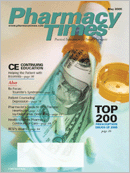Publication
Article
Pharmacy Times
Broadening Pharmacy's Role: Continuity of Care
Author(s):
People sometimes seem to have more continuity with hairstylists than with health care providers. For pharmacy services, consumers may use mail-order services, pharmacies located in medical office complexes, and chain and grocery store pharmacies simultaneously. The resulting fragmentation undermines continuity of care (CoC), increasing medication management problems and poor outcomes.1
When CoC is absent, professionals work in a vacuum. Its presence, however, leads to impressive outcomes: shorter hospitalizations, fewer emergency admissions, improved patient satisfaction, reduced costs and utilization, more effective disease management, and increased patient attention to risk factors such as diet, weight, blood pressure, and tobacco and alcohol use.1
Although every health care discipline emphasizes CoC, its meaning is colloquial?meanings differ by locale. Concepts such as seamless care, continuum of care, case management, and discharge planning cloud interpretation further.2 In primary care, CoC means having a long-term relationship with a single provider beyond acute illnesses. In mental health, however, it expands to care coordination among multiple providers, including such support services as housing and employment.2
Three core components unite CoC definitions:
- Informational continuity links disease and patient information from one provider to the next
- Management continuity coordinates care so that interventions are complementary
- Relational continuity creates a continuous therapeutic relationship with a practitioner and a coherent framework linking past, current, and future care2
Pharmacy's CoC focus is professional responsibility for ensuring continuity of pharmaceutical care as patients move from one setting to another.3 This longitudinal coordinating process puts medication management at center stage.4 Inadequate pharmacy CoC results in improper or subtherapeutic dosing, drug interactions, treatment failures, drug use without indication, and failure to receive medications.5 Table 1 lists characteristics that cultivate pharmacy continuity.
Barriers
CoC gaps exist in every setting, but they are minimized when patients are connected to a single care setting. Self-contained care systems, such as inpatient or long-term care units, foster information sharing and care coordination.
Problems tend to cascade, however, when patients transfer among care settings. Hospital and community pharmacists may not communicate effectively with one another, and, for many patients, concerted pharmacist oversight often ends at discharge.6,7 Ironically, patients often have the greatest need of oversight at this time; discharge regimens are frequently more complex than preadmission regimens.7
Not surprisingly, patient transfers have received the greatest amount of attention in resolving pharmacy's CoC gaps. The American Society of Health-System Pharmacists (ASHP) has identified 8 practice gaps, any one of which can derail continuity (Table 2).4
Developing effective strategies to abolish barriers and gaps may appear daunting, short of overhauling the profession. Research demonstrates, however, that low-tech and inexpensive interventions are effective. In a randomly controlled study, pharmacists called patients 2 days following inpatient discharge. They identified and resolved medication-related problems for 19% of the patients and identified new medical problems requiring referral for 15%. Follow-up data indicated that the patients who were contacted had fewer subsequent emergency department visits, compared with controls who were discharged without pharmacy follow-up.8
In another study, discharged patients who averaged 4.8 prescriptions were given a 1-page pharmacy-to-pharmacy referral form providing diagnosis, medication regimen, indications for each medicine, discharge medications, medical history, and drug allergies. A copy was mailed to the patients' pharmacy. Follow-up interviews found that 87% of the pharmacists receiving the summary reported that it allowed them to focus on counseling, and 62% indicated that they used it to update patient databases for future reference.9
Time for Action
Pharmacy associations are urging members to advocate CoC medication management aggressively. The ASHP's 2003 initiative targets 2015 for the achievement of 6 goals and 31 initiatives. Goals focus on greater pharmacist involvement, patient contact, medication management, counseling, and communication. The goals also promote electronic prescribing. Two examples of specific initiatives are as follows:
- 75% of inpatients with complex and high-risk medication regimens will receive discharge medication counseling provided by a pharmacist
- 90% of hospital pharmacies will ensure that patients discharged after myocardial infarction will receive beta-blockers10
Additionally, ASHP has created several action steps advocating systemwide strategies for improving CoC, such as establishing pharmacy organization coalitions, supporting care continuity research, and participating in standard setting for patient safety.11
Project Continuity of Care
CoC is problematic under the best of circumstances but virtually disappears during natural disasters. Medical emergencies tend to turn patients from poor historians into horrible historians. The aim of the American Academy of Family Practice's newly launched Project Continuity of Care (http://www.centerforhit.org/x1512.xml) is to improve continuity using a standardized electronic file containing essential patient-specific medical information or portable personal health records. Patients would carry printable Portable Document Format or Microsoft Word-formatted medical information on an inexpensive Universal Serial Bus drive.12 Health care providers could access information when and where it is needed?an approach that both practitioners and patients like.
More Than Lip Service
Patients themselves value CoC, with 91.5% rating it very important in one survey. Investing time and money for continuity, however, was less popular: only 22.2% were willing to drive more than 60 minutes; and only 18.2% were willing to spend an additional $20 to $40 per month to maintain CoC.13 People recognize the importance of CoC, but their unwillingness to invest time and money suggests that they may not fully understand negative outcomes associated with poor continuity. Patient education by pharmacists must complement practitioner efforts, emphasizing the importance of CoC.
Final Thought
CoC is rapidly becoming one of pharmacy's core values and responsibilities. Greater pharmacist involvement in patient counseling, medication management, and discharge planning is pharmacy's future.
Ms. Wick is a senior clinical research pharmacist at the National Cancer Institute, National Institutes of Health. The views expressed are those of the author and not those of any government agency.
For a list of references, send a stamped, self-addressed envelope to: References Department, Attn. A. Stahl, Pharmacy Times, 241 Forsgate Drive, Jamesburg, NJ 08831; or send an e-mail request to: astahl@ascendmedia.com.







